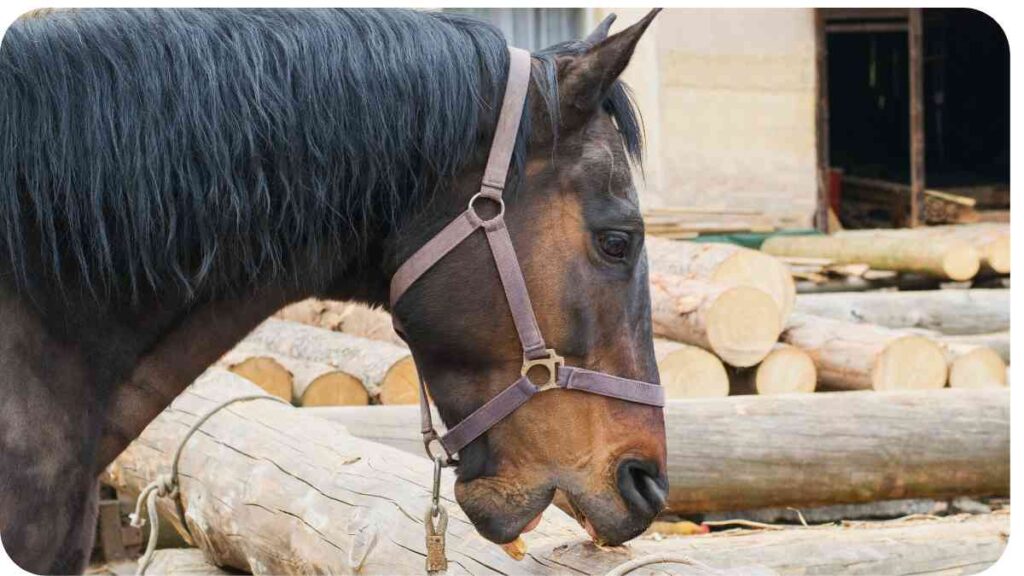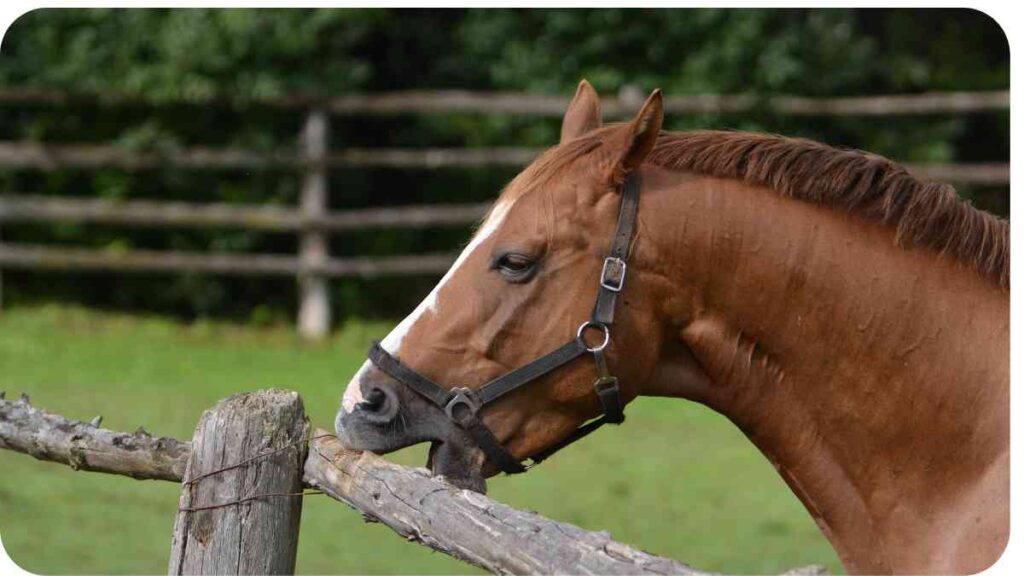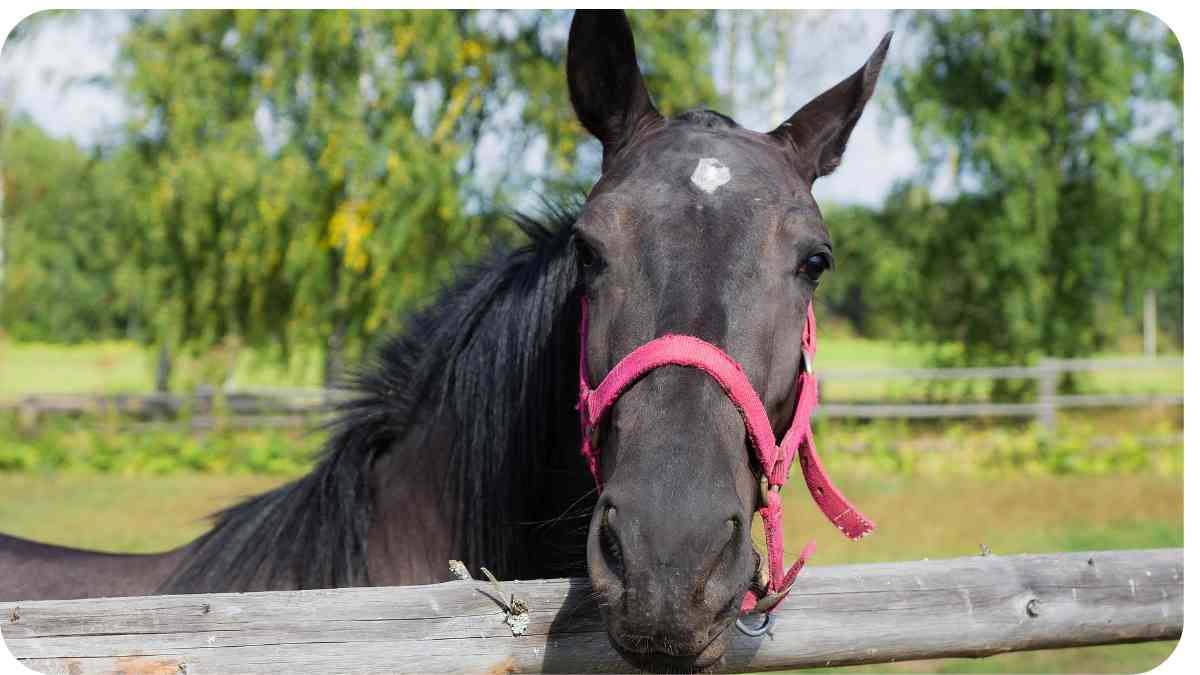Welcome to our comprehensive guide on managing cribbing in horses, a common behavioral problem that can affect their well-being. As an experienced SEO content writer with a deep understanding of equine behavior, I want to share my expertise with you.
In this article, we’ll explore the reasons behind cribbing, its impact on your horse’s health, and practical strategies to manage this challenging behavior. Whether you’re a horse owner, trainer, or enthusiast, the information provided here will empower you to effectively handle cribbing and improve your horse’s quality of life.
| Takeaways |
|---|
| – Implement environmental adjustments, such as increased turnout time and providing companionship, to reduce cribbing triggers. |
| – Balanced diet with ample forage and appropriate mineral intake can help reduce the urge to crib. |
| – Regular exercise and varied activities help alleviate stress and boredom, reducing the likelihood of cribbing. |
| – Collaborate with a veterinarian for routine health evaluations and potential medical interventions. |
| – Seek professional help from an equine behavior specialist if cribbing persists or significantly impacts the horse’s quality of life. |
| – Prevention in young horses through socialization, regular turnout, and a well-designed stable environment. |
| – Explore natural remedies and alternative therapies under professional guidance. |
| – Utilize training techniques, positive reinforcement, distractions, and consistent corrections to deter cribbing behavior. |
| – Real-world case studies provide insights into successful cribbing management strategies. |
| – Frequently asked questions address common concerns related to cribbing in horses. |
2. Understanding Horse Cribbing
Before delving into managing cribbing, it’s crucial to understand this behavior. Cribbing, also known as wind-sucking, is a repetitive act where a horse grasps a solid object with their incisor teeth, arches their neck, and inhales air. This behavior is often accompanied by the horse making a distinct grunting or groaning sound.
Understanding the signs and symptoms of equine colic is crucial for every horse owner. Recognizing early warning signs and taking preventive measures can significantly improve your horse’s well-being.
To help you better grasp the impact of cribbing, let’s take a closer look at some common signs and effects.
| Signs of Cribbing | Effects of Cribbing on Horses |
| Wood chewing | Dental problems |
| Fence and stall biting | Digestive issues |
| Gorging on food | Risk of colic |
| Weight loss | Behavioral issues |
By recognizing these signs early on, you can take proactive measures to manage cribbing and reduce its negative consequences.
3. Why Do Horses Crib?

Understanding the root causes of cribbing can help in effectively managing the behavior. While the exact reasons remain unclear, several factors may contribute to a horse’s inclination to crib. It’s essential to address these underlying causes to curb the behavior effectively.
Some potential reasons for cribbing include:
- Boredom and stress: Horses kept in confinement or with limited social interaction may resort to cribbing as a coping mechanism.
- Dietary factors: Imbalanced diets or long periods without forage can contribute to cribbing behavior.
- Weaning and socialization issues: Foals separated from their mothers prematurely or those lacking socialization can develop cribbing habits.
By understanding why your horse cribs, you can implement appropriate management strategies that target the specific cause.
4. Signs of Cribbing
Identifying cribbing behavior involves observing your horse’s habits closely. Some common signs to look out for include:
- Repeatedly biting or grasping objects, such as fence posts or stall doors.
- Arching the neck and swallowing air while making a distinct grunting sound.
- Abnormal wear patterns on the incisor teeth.
- Weight loss or poor body condition despite a good diet.
By recognizing these signs, you can intervene promptly and minimize the negative impact of cribbing on your horse’s overall well-being.
Regular vet check-ups are essential for horse health. Routine examinations and vaccinations are key to managing various equine issues, including addressing cribbing behavior effectively.
5. Effects of Cribbing on a Horse’s Health
Managing cribbing is crucial because this behavior can lead to various health issues over time. The constant pressure exerted on a horse’s teeth and digestive system can result in dental problems, digestive disturbances, and an increased risk of colic. Furthermore, weight loss and behavioral issues are common outcomes of cribbing, affecting a horse’s overall happiness and performance.
To understand the effect of cribbing more comprehensively, let’s take a closer look at the potential consequences.
| Potential Health Issues due to Cribbing |
| Dental problems |
| Digestive disturbances |
| Increased risk of colic |
| Weight loss |
| Behavioral issues |
As responsible horse owners, it is our duty to address cribbing promptly and implement appropriate interventions to maintain our horses’ health and happiness.
6. Managing Cribbing Behavior
Now that we have a better understanding of cribbing and its impact, let’s explore effective strategies for managing this
challenging behavior. Managing cribbing requires a multifaceted approach that focuses on environmental adjustments, dietary modifications, exercise and enrichment, and collaboration with a veterinarian.
Learn about common horse illnesses and their implications for your horse’s health. Prevention is the key to managing cribbing issues while keeping your equine friend in top shape.
6.1. Environmental Adjustments
Making appropriate changes to your horse’s environment can help reduce the triggers and opportunities for cribbing. Consider the following adjustments:
- Increase turnout time: Allowing your horse ample time in a pasture or paddock with other horses can promote natural behaviors and reduce stress.
- Provide companionship: Horses are social animals, and loneliness or isolation can contribute to cribbing. Ensure your horse has suitable companions.
- Minimize boredom: Use feeders or toys that encourage natural foraging behaviors, such as slow feeders or treat-dispensing balls, to keep your horse mentally stimulated.
6.2. Dietary Modifications

A well-balanced diet plays a crucial role in managing cribbing behavior. Consider the following dietary modifications:
- Increase forage intake: Provide your horse with free-access to good quality hay or pasture to keep their digestive system satisfied and reduce the urge to crib.
- Consider a cribbing collar: Consult with your veterinarian about the use of a cribbing collar, which restricts the horse’s ability to perform the behavior. However, this should be used as a last resort and under professional guidance.
- Balance mineral intake: Ensure your horse’s diet contains appropriate levels of essential minerals and vitamins, as deficiencies can contribute to cribbing tendencies.
6.3. Exercise and Enrichment
Regular exercise and mental stimulation are essential for managing cribbing. Consider the following strategies:
- Provide ample exercise: Regular exercise helps alleviate stress and boredom, reducing the likelihood of cribbing. Aim for at least 30 minutes of exercise daily.
- Practice varied activities: Incorporate a variety of activities into your horse’s routine, such as trail rides, ground work, or obstacles, to keep them engaged and mentally stimulated.
- Utilize turnout time: Allow your horse to move freely in a safe area during turnout. This promotes natural behaviors and helps reduce anxiety.
Before hitting the trails, understand the importance of horse riding etiquette. Proper trail manners and communication with fellow riders play a role in managing behavioral concerns during rides.
6.4. Collaborating with a Veterinarian
Working with a veterinarian is essential when managing cribbing. They can provide guidance on specific situations, underlying health issues, and potential treatments. Consider the following:
- Routine health evaluations: Regular veterinary check-ups help identify any underlying health conditions contributing to cribbing.
- Medical interventions: In some cases, your veterinarian may recommend medication or supplements to address underlying issues or manage stress.
Remember to consult with your veterinarian to develop a comprehensive management plan tailored to your horse’s individual needs.
7. When to Seek Professional Help
In some cases, managing cribbing may require the assistance of an equine behavior specialist, who can provide expert guidance and support. Contact a professional if your horse’s cribbing behavior persists despite implementing management strategies or if it significantly impacts their quality of life.
8. Preventing Cribbing in Young Horses
Premature intervention can help minimize the development of cribbing habits in young horses. Consider the following preventive measures:
- Socialization: Ensure young horses have access to appropriate socialization opportunities with both horses and other animals.
- Regular turnout: Young horses should have daily access to turnout, allowing them to engage in natural behaviors and social interactions.
- Stable environment: Provide a well-designed stable environment with ample space, natural light, and suitable enrichment to reduce stress and promote overall well-being.
Properly cooling down your horse is an essential aspect of care. Learn how to do it with this easy guide. Effective post-activity cool-down can contribute to managing cribbing behaviors and overall horse well-being.
9. Natural Remedies and Alternative Therapies
Some horse owners explore natural remedies and alternative therapies to manage cribbing behaviors. While these may not work for every horse, some individuals may find relief through the following approaches:
- Herbal supplements: Consult with your veterinarian about herbal supplements that may help reduce anxiety and stress.
- Acupuncture or chiropractic treatments: Some horses respond positively to these alternative therapies, which can help address imbalances and promote relaxation.
Remember, it is crucial to consult with professionals and experts in these fields to ensure the safety and efficacy of any alternative treatments.
10. Training Techniques to Deter Cribbing
Training plays a pivotal role in managing cribbing behaviors. Consider incorporating the following techniques:
- Positive reinforcement: Reward desired behaviors, such as standing quietly or engaging in appropriate activities, with treats or praise.
- Distraction techniques: Provide distractions, like toys or engaging activities, to redirect your horse’s attention away from cribbing triggers.
- Consistent correction: If you catch your horse in the act of cribbing, calmly correct them with a vocal cue or redirection.
11. Case Studies: Successful Cribbing Management
Real-world examples provide valuable insights into successful cribbing management. Let’s explore a couple of cases where horses overcame cribbing habits:
Case Study 1
In this case, a Thoroughbred named Lucky exhibited severe cribbing behavior due to anxiety and boredom. By implementing a personalized management plan, including increased turnout time, the addition of equine companions, and daily exercise routines, Lucky’s cribbing reduced significantly.
His overall well-being improved, and he was able to engage in natural behaviors without resorting to cribbing.
|Another case involved a Warmblood named Bella, who developed cribbing as a result of dietary imbalances and high-stress levels. Through careful dietary adjustments, providing a constant source of forage, and incorporating stress-relief activities like equine massage and aromatherapy, Bella’s cribbing behaviors diminished.
She became more content and enjoyed a healthier, cribbing-free life.
By studying these cases, we can learn valuable lessons about the importance of a holistic and individualized approach to cribbing management.
12. Frequently Asked Questions (FAQs)
- Can cribbing cause physical harm to horses?
- While cribbing itself is not physically harmful, the constant pressure on a horse’s teeth and gastrointestinal tract can lead to dental problems, digestive disturbances, and an increased risk of colic.
- Can cribbing be cured completely?
- While complete elimination of cribbing behavior may be challenging, effective management strategies can significantly reduce the frequency and intensity of cribbing, leading to a better quality of life for the horse.
- Do cribbing collars work?
- Cribbing collars, when used as a last resort and under professional guidance, can help restrict a horse’s ability to perform the behavior. However, they should not be seen as a standalone solution and should always be accompanied by a comprehensive management plan.
- Can changing a horse’s diet help with cribbing?
- A balanced diet with ample forage can reduce the urge to crib. Ensuring access to high-quality hay or pasture and addressing any nutritional deficiencies can aid in managing cribbing behavior.
- Is cribbing a learned behavior?
- While some horses may learn cribbing behaviors from observing other horses, many cases of cribbing are believed to have underlying physiological or psychological causes. It is crucial to address these underlying issues alongside training techniques.
- Are there any long-term consequences of cribbing?
- Prolonged cribbing can have adverse effects on a horse’s dental health, digestive system, and overall well-being. Timely intervention and comprehensive management strategies are essential to mitigate long-term consequences.
Further Reading
Here are some additional resources for further reading on managing cribbing behavior in horses:
- Why is My Horse Cribbing and Can I Make Him Stop?: This article by Farnam provides insights into the reasons behind cribbing behavior and offers tips on how to address and manage it effectively.
- Thinking About Cribbing: Equus Magazine presents an in-depth look at cribbing, its possible causes, and various management options, including environmental adjustments, dietary modifications, and training techniques.
- 4 Ways to Manage a Cribbing Horse: AGDAILY provides four practical approaches to managing cribbing behavior in horses, including dietary adjustments, environmental improvements, and the use of cribbing collars.
These resources will provide you with additional insights and strategies for effectively managing cribbing behavior in your horse.
FAQs
Can cribbing cause physical harm to horses?
Cribbing itself is not physically harmful, but the constant pressure on a horse’s teeth and gastrointestinal tract can lead to dental problems, digestive disturbances, and an increased risk of colic.
Can cribbing be cured completely?
While complete elimination of cribbing behavior may be challenging, effective management strategies can significantly reduce the frequency and intensity of cribbing, leading to a better quality of life for the horse.
Do cribbing collars work?
Cribbing collars, when used as a last resort and under professional guidance, can help restrict a horse’s ability to perform the behavior. However, they should not be seen as a standalone solution and should always be accompanied by a comprehensive management plan.
Can changing a horse’s diet help with cribbing?
A balanced diet with ample forage can reduce the urge to crib. Ensuring access to high-quality hay or pasture and addressing any nutritional deficiencies can aid in managing cribbing behavior.
Is cribbing a learned behavior?
While some horses may learn cribbing behaviors from observing other horses, many cases of cribbing are believed to have underlying physiological or psychological causes. It is crucial to address these underlying issues alongside training techniques.
These frequently asked questions provide concise answers to common concerns about cribbing behavior in horses.

Hi there! My name is Hellen James, and I’m a horse riding expert. I’ve been riding horses since I was just a kid—and it’s been my passion ever since. But getting started with horse riding can be overwhelming. There’s so much to learn! If you’re looking for a way to get started and make sure you’re doing it right, I’m here to help.


